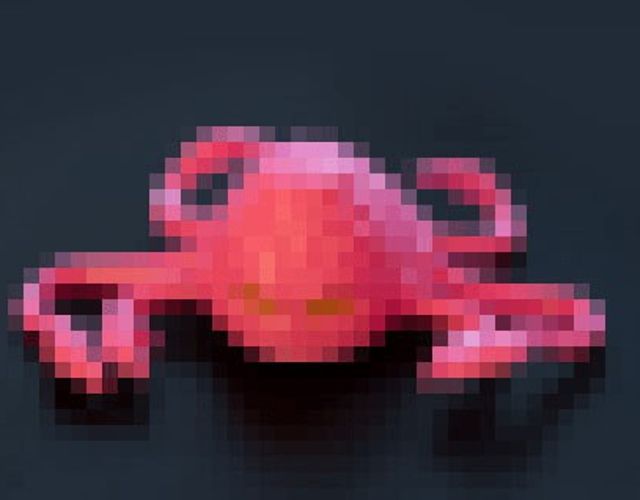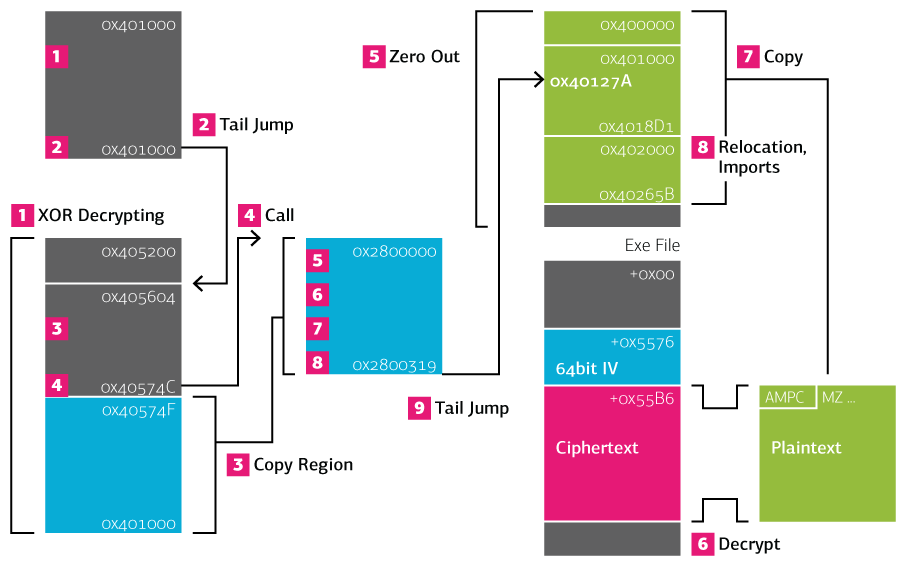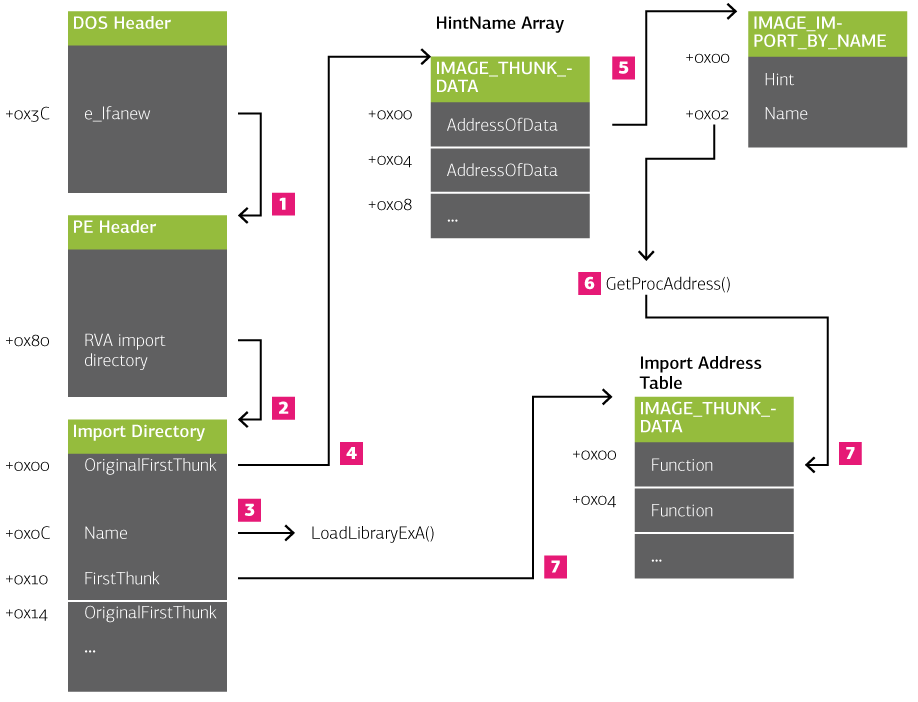Win32/Upatre.BI - Part One
Unpacking- June 10, 2015
- reverse engineering
- malware analysis upatre
- no comments
- Stage 1
- CatSrv.dll
- Image Size of CatSrv.dll
- Unpacking
- Tail Jump
- Stage 2
- Find Kernel32
- Modify the Entry Point
- Resolve API addresses
- Copy Unpacking Stub
- Unpacking
- Copy
- Relocation and Imports
For more information about the malware in this blog post see the Malpedia entry on Upatre.
- Part 2: Config (June 14, 2015)
- Part 3: Main Loop (June 16, 2015)
- Part 4: Payload Format (June 20, 2015)
Win32/Upatre.BI is a recent member of the Upatre downloader family. The malware is usually spread by email attachments. It can steal user information and download a variety of other malicious software such as Zeus, Rovnix, Dyzap or Cutwail. In this multi-part blog post I analyze the inner workings of Upatre.BI by reversing the following sample:
- Filename
- OGdbzU.exe
- Filesize
- 48128 bytes
- MD5
- 99807df2c2b2cdbff9e373611b07cf48
- SHA-256
- 08acd0c50dbb6d712c54d25a5ccd99c1d6faf9ad2031e56884a0af991e3fda78
- Malwr
- https://malwr.com/analysis/YThlYTU5MmE4OTAyNDEzNTllYjdkZThmODQ5ZTRkYjA/
The sample is well detected by all popular antivirus scanners:
- Kaspersky
- Trojan-Downloader.Win32.Upatre.aacs
- McAfee
- RDN/Upatre-FABV!a
- Microsoft
- Win32/Upatre.BI
- Sophos
- Troj/Upatre-LD
- Symantec
- Downloader.Upatre!gen9
- TrendMicro
- TROJ_UPATRE.SMC1
This first part of the series focuses on the initial step in reversing the malware: unpacking. The Upatre sample is not technically packed — in fact the unpacked payload is about a quarter the size — but it is protected by two decryption stages. The first stage uses a simple XOR and ROL encryption, while the second stage uses a variant of RC4. The following illustration gives an overview of the two unpacking stages.
- The first unpacking stub modifies part of the memory with ROL and XOR.
- At the end of the first stage, the tail jump enters the unpacked memory.
- The second stage copies the unpacking stub code region to a newly allocated page.
- A call is made to the copied region.
- Most of the loaded executable, including the PE header, is zeroed out.
- The encrypted payload is loaded from the executable file and decrypted.
- The decrypted plain text contains the new executable. It is copied to the image base.
- The unpacking stub handles relocation and resolving the imports.
- The tail jump into the decrypted executable concludes the second unpacking stage.
The remainder of the blog posts provides details about the individual unpacking steps.
Stage 1
The first unpacking stub is very simple. It first checks the size of a Windows DLL before decrypting the second stage and jumping to it.
CatSrv.dll
Upatre.BI checks the catsrv.dll in the Windows system directory. The system directory is determined with the following call:
0040103F call ds:GetSystemDirectoryA
00401045 call append_catsrv_dll
The routine append_catsrv_dll then appends the name \catsrv.dll. The DLL name is hard-coded with some slight obfuscation:
004011E1 mov edx, 'lld'
004011E6 push edx
004011E7 mov edx, '.vru'
004011EC sub edx, 2 ; -> .vrs
004011EF push edx
004011F0 mov edx, 'tac[' ; -> tac\
004011F5 inc edx
004011F6 push edx
The same obfuscation method — shifting letters — is also used in the unpacked payload. This might indicate that the paylaod and the protector were written by the same authors.
Image Size of CatSrv.dll
The sample reads the contents of c:\windows\system32\catsrv.dll with fopen. The address of the API function is manually determined by reading the import address table, whose location is hard-coded:
00401006 mov ebx, 65758h
...
00401021 add ebx, 39E8A8h ; -> 0x404000 (.idata)
The offsets 0x404000 points to the import directory if the .idata section is placed there:

If the import directory is loaded somewhere else, then a memory reference error will occur and the process crashes. The sample retrieves the import at offset 0x7C:
0040105E sub eax, eax
00401060 add eax, 7Ch
00401065 add eax, ebx ; -> eax = fopen
...
0040107C call dword ptr [eax]
which is fopen:
.idata:0040407C extrn fopen:dword
It then uses this MS VC++ routine to read the SizeOfCode value of the catsrv.dll by reading field 0x1C into the PE header:
0040109E call ds:fread
004010A4 mov eax, esi
004010A6 add eax, 3Dh
004010AB dec eax ; -> offset 3C = real PE header
004010AC mov eax, [eax]
004010AE add eax, esi
004010B0 push 1Eh
004010B2 pop edi
004010B3 dec edi
004010B4 dec edi ; -> edi = 1C
004010B5 mov eax, [eax+edi] ; -> size of code
The SizeOfCode needs to be 768 or larger than 131581, otherwise the unpacking step is skipped and the malware will crash.
Unpacking
Upatre arrives at this unpacking loop if the DLL size is in order:
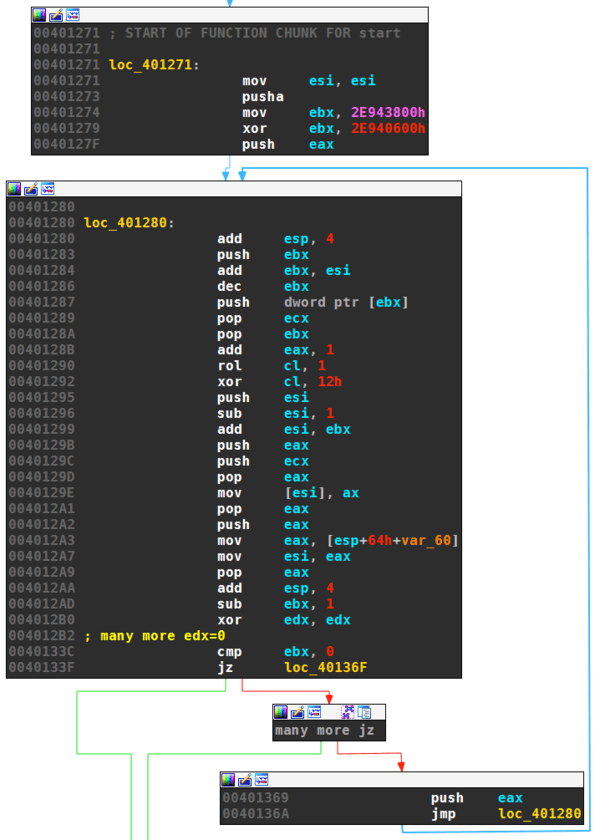
The two XOR instructions at the initialization calculates 0x3E00, which is the size of the packed region. The start of the packed region is pointed to by esi, which was set to 0x405200 at the entry point:
00401000 push 83h
...
0040101B add esi, 40517Dh
The unpacking routine decompiles to the following simple routine:
for i from 0x405200 to 0x408FFF
Byte(i) = ROL(Byte(i), 1) ^ 0x12
endfor
Where ROL denotes the rotate on left instruction.
Tail Jump
The first unpacking stage concludes by jumping to 0x405604 inside the decrypted area:
0040119C mov edi, 40520Ah
004011A1 xor eax, eax
004011A3 add esp, 3Ch
004011A6 jmp return
...
00401375 return:
00401375
00401375 add edi, 3FAh
0040137B push edi
0040137C retn -> 0x405604
Stage 2
The second unpacking stage is slightly more complicated than the first. Instead of using simple XOR/ROL obfuscation, it uses an RC4 variant as protection. It also features manual resolving of API addresses.
Find Kernel32
The first step of the second stage is to laod the base address of the kernel32 library:
0040560C call get_kernel32
The routine performs the following steps:
mov ebx, large fs:30h -> TIB -> PEB
mov ebx, [ebx+0Ch] -> PEB -> PEB_LDR_DATA
mov ebx, [ebx+0Ch] -> PEB_LDR_DATA -> InLoadOrder
mov ebx, [ebx] -> second element (ntdll)
mov ebx, [ebx] -> third element (kernel32)
mov eax, [ebx+18h] -> LDR_MODULE -> DllBase
The first three lines get the InLoadOrder ListEntry, located at offset 12 into the PEB_LDR_DATA, which is located at offset 12 into the PEB at offset 0x30 into the TIB. The code then follows the forward link of the doubly linked list InLoadOrder twice to get to the third element. The third module that is loaded after the process and ntdll is kernel32. The code finally retrieves the DllBase at offset 0x18 into the LDR_MODULE for kernel32.
Modify the Entry Point
While the malware relies on the kernel32 being the third loaded module, it uses a more robust method to locate the current process. The malware first determines it’s image base with the following instructions:
00405614 call $+5
00405619 pop eax
0040561A xor ax, ax
These lines round the current EIP down to the image base. As in get_kernel32, the code looks up the InLoadOrder list. It traverses this list until it finds the module that matches the image base, i.e., the current process:
0040562C push large dword ptr fs:30h
00405633 pop eax
00405634 loc_405634:
00405634 mov eax, [eax+0Ch]
00405637 mov eax, [eax+0Ch]
0040563A loc_40563A:
0040563A cmp [eax+18h], ebx
0040563D jz short loc_405643
0040563F mov eax, [eax]
00405641 jmp short loc_40563A
The malware then sets the image base of the current process to zero (will be fixed later), and the entry point at offset 0x1C to the original entrypoint 0x127A. Both values will later be overwritten.
00405627 mov esi, 127Ah
00405643 mov [eax+18h], edi
00405646 mov [eax+1Ch], esi
Resolve API addresses
Upatre.BI imports all system APIs manually by calling a routine getProcByHash. It has the following prototype:
getProcByHash(dll, hash)
The first parameter dll is the address of the kernel32 DLL resolved earlier. The second argument hash is 32 bit value tied to a specific procedure in kernel32. The disassembly of the routine looks as follows.

This constitutes a very common way of finding imports by malware, as illustrated by the following image:
- The offset to the PE header is read from the DOS header.
- The offset to the export directory is read from the PE header.
- The offset to the export names table is read from the export table.
- Every name in the names table is hashed and the result compared to the desired hash.
- When a name produces the correct hash (in the example the routine GetProcAddress, then the corresponding row is looked up in the export ordinals table, e.g., 0x244.
- In the export address table the row that corresponds to the ordinal is read. This is the RVA to the desired procedure.
- To get the absolute address, the base address of the DLL is added (in our example 0x75200000).
The hashing routine is simple, yet not trivial to reverse:
for letter in string
hash = 0
hash = ROL(hash, 7)
hash = hash ^ letter
endfor
It is used to conceal the names of the following kernel32 functions:
- GetProcAddress
- VirtualProtect
- LoadLibraryExA
- GetModuleHandleA
- VirtualAlloc
- GetModuleFileNameA
- CreateFileA
- SetFilePointer
- ReadFile
- VirtualFree
- CloseHandle
- GetModuleHandleA
Copy Unpacking Stub
The second unpacking stage overwrites large parts of the loaded code. It therefore first saves the remaining code by copying it to newly allocated pages. The size is set to the image size of the loaded exe (which is more than enough):
00405709 mov [ebp+image_base], eax
0040570C mov eax, [eax+pe.e_lfanew]
0040570F add eax, [ebp+image_base]
00405712 mov [ebp+pe_header_], eax
00405715 mov eax, [eax+pe.SizeOfImage]
00405718 mov [ebp+size_of_image], eax
0040571B push 40h
0040571D push 1000h
00405722 push [ebp+size_of_image]
00405725 push 0
00405727 call [ebp+kernel32_VirtualAlloc]
0040572A mov [ebp+unpacking_stub], eax
Then 0x694 bytes starting from 0x4057F (0x40573A + 0x15) are copied to the newly allocated space:
00405732 mov [ebp+hThisProcess], eax
00405735 call $+5
0040573A pop eax
0040573B add eax, 15h
0040573E push 694h
00405743 push [ebp+unpacking_stub]
00405746 push eax ; 0040574f
00405747 call copy_
Finally, the copied code is run:
0040574C call [ebp+unpacking_stub]
The copied code follows right after the previous call. In the following I report the offsets at their original location.
Unpacking
Before the payload is unpacked, Upatre cleans any trace of the current image by zeroing out the memory from the image base.
00405828 mov edi, [ebp+image_base]
0040582B mov ecx, [ebp+SizeOfImage]
0040582E shr ecx, 2
00405831 xor eax, eax
00405833 rep stosd
The original payload lies encrypted at a fixed location into the executable file. The encryption method is VMPC RC4 with a 64 bit IV and 64 bit key, generated by a modified LCG. Starting at 0x5576 bytes into the exe, Upatre first reads 64 bytes as the initialization vector. Following that, it reads the 0x1A44 bytes long ciphertext:
GetModuleFileNameA(-1, &path_to_exe, ...)
h = CreateFileA(&path_to_exe, ...)
SetFilePointer(h, 0x5576, 0, 0)
ReadFile(h, &iv, 0x40, ...)
ReadFile(h, &ciphertext, 0x1A44, ...)
Upatre then creates the decryption key:
00405838 push [ebp+key]
0040583B call generate_key
The key generation routine decompiles to the following pseudo-code:
procedure generate_key(key[64], seed)
for i from 0 to 63
ix = 16807 * ((seed ^ 123456789) % 12773) - 2836 * ((seed ^ 123456789) / 12773)
if ix < 0 then
ix += 0x7FFFFFFF
end if
key[i] = ix
seed = ix ^ 123456789
end for
This resembles the LCG-rand implementation in C, except:
- the additional encryption of the seed with XOR 123456789
- 12773 is used instead of 127773.
The second modification makes no sense, because the number can’t be freely chosen but rather depends on the modulus and factor of the LCG. Chosing a different values breaks Schrage’s trick.
The next step of RC4 is the initialization of the permutation S:
procecedure vmpc_initialization(S[256])
for i from 0 to 255
S[i] = i
end for
The permutation is then scrambled with the following algorithm:
procedure vmpc_scrambling(S[256], vec, veclen, j)
for m from 0 to 3*256 - 1
i = m % 256
j = S[j + vec[m % veclen] + S[i]]
swap( S[i], S[j] )
end for
return j
The scrambling routine is first called with the key as the second parameter, then again with the IV. After these KSA steps, the decryption of the ciphertext is carried out using the PRGA variant of VMPC:
procedure vmpc_prga(S[256], ciphertext, ciphertext_len, j)
for a from 0 to ciphertext_len -1
i = m % 256
j = S[(S[i] + j) % 256]
ciphertext[m] = c[m] ^ S[(S[S[j]] + 1) % 256]
swap( S[i], S[j] )
return j
As seen earlier, the key for the decryption is calculated by a modified LCG based on a seed. This seed stored nowhere in the binary, but rather brute-forced by the unpacking stub: at first, the decryption is carried out for the first four bytes of the ciphertext for every seed starting with 0 until the plaintext reads “AMPC” (for my sample with the seed 0x45). The key is then used to decrypt the remainder of the ciphertext. The following pseudo-code summarizes the decryption of the payload.
seed = 0
IV = exe_file[0x5576 : 0x557A]
c = exe_file[0x557A : 0x6FBE]
while True
generate_key(key, seed)
vmpc_initialization(S)
j = vmpc_scrambling(S, key, 64, 0)
j = vmpc_scrambling(S, iv, 64, j)
magic = c[0:4]
j = vmpc_prga(S, magic, 4, j)
if magic = "AMPC"
break
else
seed = seed + 1
end if
end while
vmpc_prga(S, c[4 : 0x6FBE], 0x1A44, j)
Copy
The decrypted payload is written to the current image base. First the PE headers protection is changed to be writable:
004058CD mov eax, [ebp+plaintext]
004058D0 mov eax, [eax+pe.e_lfanew]
004058D3 add eax, [ebp+plaintext]
004058D6 mov [ebp+pe_header], eax
004058D9 mov eax, [eax+pe.nr_of_sections]
004058DC mov word ptr [ebp+nr_of_sections], ax
004058E0 mov ebx, [ebp+pe_header]
004058E3 mov ebx, [ebx+pe.SizeOfHeaders]
004058E6 mov eax, ebp
004058E8 sub eax, 48h
004058EB push eax ; prev header protectiong
004058EC push PAGE_EXECUTE_READWRITE
004058EE push ebx
004058EF push [ebp+image_base]
004058F2 call [ebp+kernel32_VirtualProtect]
then the header is overwritten by the header of the payload:
004058F5 push ebx ; size of headers
004058F6 push [ebp+image_base] ; dst
004058F9 push [ebp+plaintext] ; src
004058FC call copy
Upatre then iterates over all sections of the payload — .text and .idata — and also copies them to the current image.
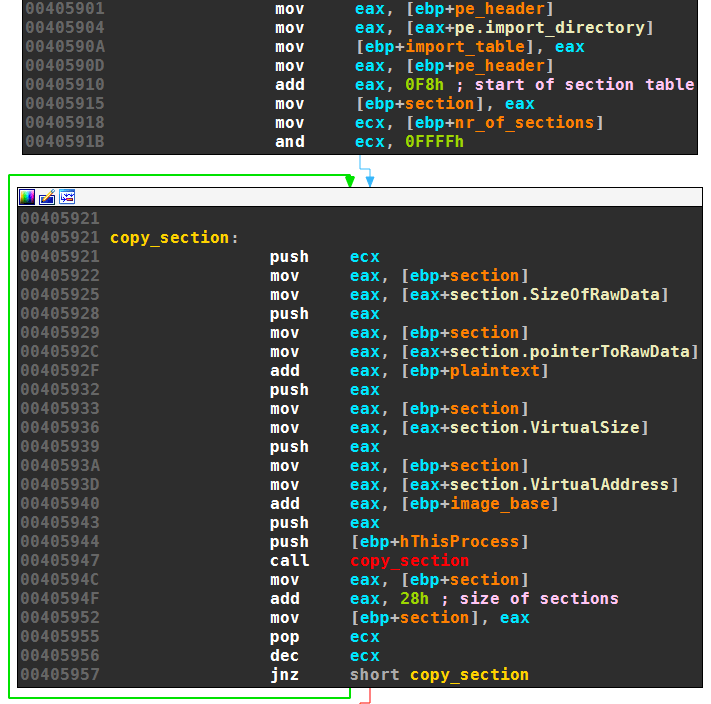
Relocation and Imports
After the header and the sections are copied, the unpacker performs relocation if necessary:
00405959 mov ebx, [ebp+image_base]
0040595C call relocate
The payload is position independent and therefore has no relocation information, so the relocation call does nothing even if the image base should not be 0x400'000. In this case, however, the first stage of unpacking would have crashed already.
Finally, the imports are manually resolved the same way the loader would resolve imports:
- The offset to the PE header is read from the DOS header.
- The offset to the import directory is read from the PE header.
- For each element in the import directory, the name at offset 0x0C is retrieved and the corresponding DLL is loaded with
LoadLibraryExA. - The array of hint names is visited by following
OriginalFirstThunk. - For each thunk in the HintNames array, the pointer is followed to the
IMAGE_IMPORT_BY_NAMEstructure. - At offset 2, the name is read and the corresponding procedure is loaded by calling
GetProcAddress()(using the DLL address from step 3). - The resolved address is stored in the IAT, which is pointed to by the
FirstThunkvalue at offset 0x10 into the import directory.
The second stage finally jumps to the unpacked payload. The unpacking stubs tries to veil the jump by setting the original entry point as the return address for an API call VirtualFree:
00405A57 mov eax, [esp+14h+image_base_]
00405A5E add eax, 127Ah
00405A63 mov [esp], eax
00405A67 pop eax
00405A68 jmp [esp+10h+VirtualFree]
The unpacked exe can then be dumped. No import reconstruction or other fixes are necessary. Interestingly, the unpacked executable has a lower detection rate than the packed version. Sophos, Symantec and TrendMicro for example classify the payload as clean (as of June 9th):
- Kaspersky
- Trojan-Downloader.Win32.Upatre.aasc
- McAfee
- Upatre-FABV!7347D2130AB5
- Microsoft
- Win32/Upatre.BI
- Sophos
- clean
- Symantec
- clean
- TrendMicro
- clean
Part 2 of this blog post series will document the data structures used by Upatre and their content.
